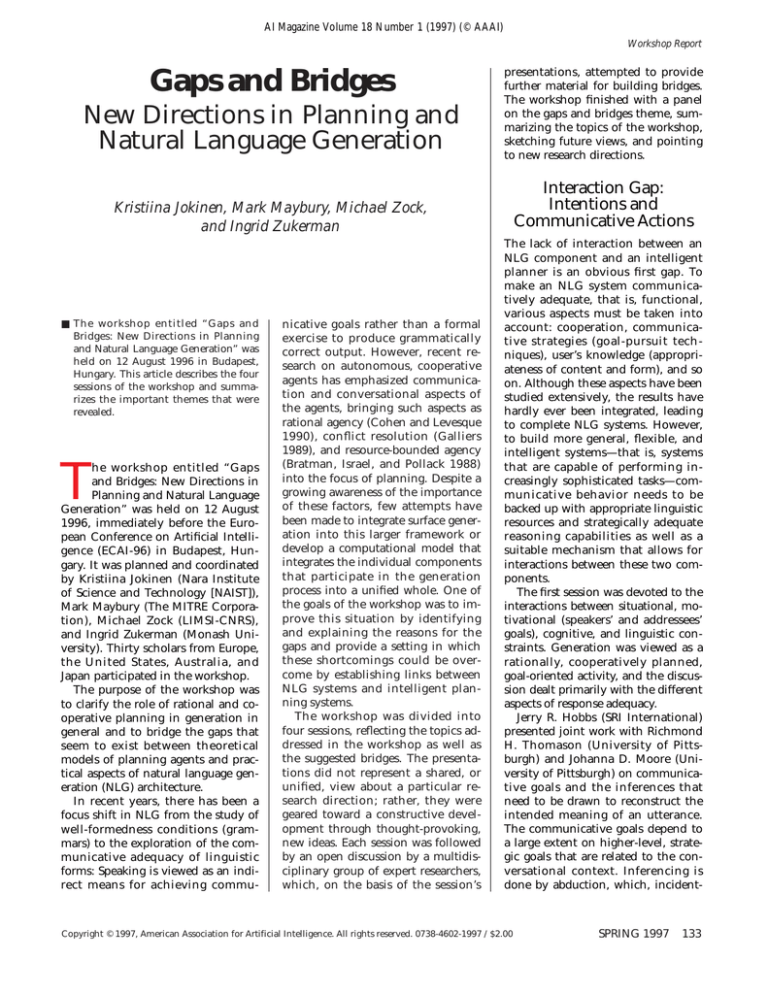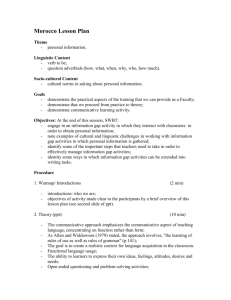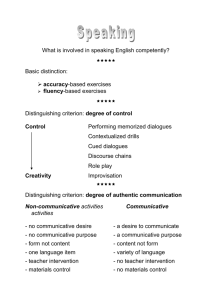
AI Magazine Volume 18 Number 1 (1997) (© AAAI)
Workshop Report
Gaps and Bridges
New Directions in Planning and
Natural Language Generation
presentations, attempted to provide
further material for building bridges.
The workshop finished with a panel
on the gaps and bridges theme, summarizing the topics of the workshop,
sketching future views, and pointing
to new research directions.
Interaction Gap:
Intentions and
Communicative Actions
Kristiina Jokinen, Mark Maybury, Michael Zock,
and Ingrid Zukerman
■ The workshop entitled “Gaps and
Bridges: New Directions in Planning
and Natural Language Generation” was
held on 12 August 1996 in Budapest,
Hungary. This article describes the four
sessions of the workshop and summarizes the important themes that were
revealed.
T
he workshop entitled “Gaps
and Bridges: New Directions in
Planning and Natural Language
Generation” was held on 12 August
1996, immediately before the European Conference on Artificial Intelligence (ECAI-96) in Budapest, Hungary. It was planned and coordinated
by Kristiina Jokinen (Nara Institute
of Science and Technology [NAIST]),
Mark Maybury (The MITRE Corporation), Michael Zock (LIMSI-CNRS),
and Ingrid Zukerman (Monash University). Thirty scholars from Europe,
the United States, Australia, and
Japan participated in the workshop.
The purpose of the workshop was
to clarify the role of rational and cooperative planning in generation in
general and to bridge the gaps that
seem to exist between theoretical
models of planning agents and practical aspects of natural language generation (NLG) architecture.
In recent years, there has been a
focus shift in NLG from the study of
well-formedness conditions (grammars) to the exploration of the communicative adequacy of linguistic
forms: Speaking is viewed as an indirect means for achieving commu-
nicative goals rather than a formal
exercise to produce grammatically
correct output. However, recent research on autonomous, cooperative
agents has emphasized communication and conversational aspects of
the agents, bringing such aspects as
rational agency (Cohen and Levesque
1990), conflict resolution (Galliers
1989), and resource-bounded agency
(Bratman, Israel, and Pollack 1988)
into the focus of planning. Despite a
growing awareness of the importance
of these factors, few attempts have
been made to integrate surface generation into this larger framework or
develop a computational model that
integrates the individual components
that participate in the generation
process into a unified whole. One of
the goals of the workshop was to improve this situation by identifying
and explaining the reasons for the
gaps and provide a setting in which
these shortcomings could be overcome by establishing links between
NLG systems and intelligent planning systems.
The workshop was divided into
four sessions, reflecting the topics addressed in the workshop as well as
the suggested bridges. The presentations did not represent a shared, or
unified, view about a particular research direction; rather, they were
geared toward a constructive development through thought-provoking,
new ideas. Each session was followed
by an open discussion by a multidisciplinary group of expert researchers,
which, on the basis of the session’s
The lack of interaction between an
NLG component and an intelligent
planner is an obvious first gap. To
make an NLG system communicatively adequate, that is, functional,
various aspects must be taken into
account: cooperation, communicative strategies (goal-pursuit techniques), user’s knowledge (appropriateness of content and form), and so
on. Although these aspects have been
studied extensively, the results have
hardly ever been integrated, leading
to complete NLG systems. However,
to build more general, flexible, and
intelligent systems—that is, systems
that are capable of performing increasingly sophisticated tasks—communicative behavior needs to be
backed up with appropriate linguistic
resources and strategically adequate
reasoning capabilities as well as a
suitable mechanism that allows for
interactions between these two components.
The first session was devoted to the
interactions between situational, motivational (speakers’ and addressees’
goals), cognitive, and linguistic constraints. Generation was viewed as a
rationally, cooperatively planned,
goal-oriented activity, and the discussion dealt primarily with the different
aspects of response adequacy.
Jerry R. Hobbs (SRI International)
presented joint work with Richmond
H. Thomason (University of Pittsburgh) and Johanna D. Moore (University of Pittsburgh) on communicative goals and the inferences that
need to be drawn to reconstruct the
intended meaning of an utterance.
The communicative goals depend to
a large extent on higher-level, strategic goals that are related to the conversational context. Inferencing is
done by abduction, which, incident-
Copyright © 1997, American Association for Artificial Intelligence. All rights reserved. 0738-4602-1997 / $2.00
SPRING 1997
133
Workshop Report
Insert IUI ‘98 Ad
ly, can be used both in interpretation
and in generation.
Alexandra Klein and Soenke Ziesche’s (both of University of Hamburg) views on planning provoked a
heated discussion. Accor ding to
them, the adequacy of an utterance is
decided in a three-step evaluation: (1)
the basic communicative goal, (2) its
contextual relevance, and (3) grammatical soundness. Time limits can
cause later stages to be ignored, yielding grammatically, or contextually ill
formed, hence odd-sounding, utterances. This is explained by the adequacy drop principle, which says that
the adequacy steps can be left out in
reverse sequential order depending
on external constraints in a resourcebounded planning process.
Alison Cawsey (Heriot Watt University) addressed the problem of
how the nature of communicative
goals and changes in the user’s cognitive attitudes affect the planning and
realization processes. The joint work
by her and Floriana Grasso (Heriot
Watt University) concerns the genera-
134
AI MAGAZINE
tion of personalized health-education
material. Their analysis of the task
and the capabilities of current discourse-planning techniques led them
to conclude that these techniques
have not yet reached a level that supports the automatic generation of all
texts that are appropriate for the delicate communicative goals at hand.
They further proposed an approach
where text generated by schemas and
even canned text can be interleaved
with automatically generated text.
The discussant of the session, Galja
Angelova (Bulgarian Academy of Sciences), discussed some general problems of planning, relating the topics
of the presentations to her joint work
with Kalina Boncheva (Bulgarian
Academy of Sciences) concerning the
generation of hypertext documents.
Argumentation Gap
Besides NLG-specific gaps, the use of
computers in collaborative settings
has revealed another gap: the use of
effective, argumentative strategies
and their computational modeling.
For example, knowledge-based systems must present convincing arguments to justify their recommendations, intelligent tutoring systems
need to explain why a particular
proposition is or isn’t true, and negotiation systems need to justify why a
particular course of action is better
than some alternative. Although
there is agreement that elaborated
reasoning is necessary to select effective argumentative strategies, there is
hardly any consensus about the nature of such structures. Previously, argumentative structures have been
cast as text schemata (Toulmin 1958),
but the extension of these simple
structures to more complex arguments is a nontrivial task. Moreover,
the identification of different parameters that affect argumentation, and
the determination of appropriate
ways of presenting an argument,
must be considered during the planning process.
Thus, the next session was devoted
to computational models of argumentation. Ingrid Zukerman (Monash University) presented the architecture of the NAG (nice argument
generator), a system capable of generating and analyzing arguments. NAG,
which was designed together with
Kevin Korb and Richard McConachy
(both of Monash University), produces arguments to convince the user
of the correctness of a goal proposition. The model relies on a variety of
knowledge sources, exhibiting abductive behavior during analysis as well
as during generation by consulting a
user model.
Nikos I. Karacapilidis (German National Research Center for Information Technology) presented an argumentation-based framework that
supports defeasible and qualitative
reasoning. In this framework, each
agent has a position with respect to
the issues that are relevant to a particular proposition. The system then
attempts to build an argumentation
that defends its position.
In his spirited presentation, Daniel
Marcu (University of Toronto) provided a compilation of features that affect
the persuasiveness of an argument
and should be taken into account
Workshop Report
when developing an argumentation
system. Chris Reed (University College
at London) described joint work with
Derek Long and Maria Fox (both of
University of Durham) concerning the
planning of persuasive arguments.
They proposed a four-level architecture for argumentation, where different types of operator are used for linking premises to conclusions. They also
suggested the use of stylistic heuristics
to increase the persuasive force of an
argument.
The discussants in this session addressed issues pertaining to computational models of argumentation, such
as the determination of appropriate
ways of presenting an argument and
the identification of parameters affecting argumentation. The discussions concerned different viewpoints
and showed the interdisciplinary
spirit of the workshop.
Insert Information Resources Ad
Generation Gap: Planning
and Generation
The famous gap between strategic
and tactical planning (Meteer 1991)
becomes even more obvious and
wider when communicatively appropriate planning is emphasized. The
linguistic realization of the speaker’s
goals is usually organized in such a
way that macroplanning precedes the
microplanning of a specific syntactic
structure and choice of words. However, to integrate the complex communicative needs of a planning agent
to language-specific constraints, more
sophisticated system architectures are
called for. Opportunistic planners, allowing for distributed processing,
hence, going beyond the traditional
two-stage generation model, seem to
be valuable candidates.
The first afternoon session explored the effects of the various constraints on the generation process as
a whole. Eduard Hovy (USC/Information Sciences Institute) focused on
sentence planning requirements and
outlined an innovative architecture
for generation, considering sentence
generation as a distinct phase of the
generation process. He proposed a
blackboard-based sentence planner
that deals with different subtasks by
activating independent modules that
incrementally rewrite and flesh out a
text structure into a fully specified list
of sentence specifications. This work
has been carried out together with
Leo Wanner (University of Waterloo).
Stephen Beale (New Mexico State
University) discussed an architecture
for context-dependent, multilingual
planning based on the semantic interactions of words in a sentence. The
starting point of the work, done together with Evelyne Viegas (New
Mexico State University), is the problem of semantic mismatches between
languages. The architecture is based
on the hunter-gatherer control strategy, which combines localized problem solving with solution synthesis
methods, using branch-and-bound
and constraint-satisfaction techniques to prune nonoptimal solutions. This constraint-based system
also supports the interaction between
intelligent planning and linguistic realization components.
Laurence Balicco reported on joint
work with Georges Antoniadis (both
of Université Stendahl) concerning a
central problem in tactical planning:
microplanning. Their work focuses
on linguistic operations (grouping
and referential operations), which
provide the basis for linguistically
correct and unambiguous text generation.
Interest Gap: Explanation
and Dialogue
There seems to be a long-standing difference in the scientific approaches
taken by theorists and engineers. Theorists tend to emphasize the innovative aspects of research, but engineers
strive for applications that prove the
usefulness of a theory for practically
oriented work. Of course, to succeed,
both approaches are needed, and interaction between them is important.
A theoretical model that cannot be
applied or tested in practice is hardly
of any use, and thus, discussion of
practical applications as test beds for
a particular theory should be encouraged. However, practical aspects
SPRING 1997
135
Workshop Report
should not be overestimated because
the implementation does not guarantee that the particular theory is valid
or that the application is useful in its
own right. Thus, a common ground
allowing a constructive interaction
between these two groups is needed.
Furthermore, a common language is
necessary because many communication problems stem from the lack of
well-defined, joint terminology.
The final workshop session concentrated on discourse generation and
the use of techniques developed in AI
and computational linguistics. Birgitta Lastow (Lund University) described
an implemented system, designed together with Bengt Sigurd and Tomas
Vävargård, which generates weather
forecasts in Swedish and English. Of
particular interest was the application
of generation techniques that cover a
wide range of generation issues.
Yllias Chali (Université Aié) explored the process of incrementally
producing longer, more elaborated
versions of a core text. The joint work
with Elsa Pascual (IRIT–Université
Paul Sabatier) and Jacques Virbel (IRIT-CNRS) is based on a Harrisian type
of sentence representation and a
question-answer str ucture that
reflects the semantic links between
sentences.
Panel: Future Directions
The workshop finished with a panel
that examined a number of areas for
future work in gaps and bridges. The
panel was led by Jokinen, and the
discussion took place between Helmut Horacek (University of Constance), Ivan Rankin (Linköping University), Arne Jönsson (Linköping
University), Zock, and Maybury.
Jokinen introduced the panel topics by discussing problems concerning the definition of conversational
adequacy, pointing out that in dialogue situations, planning an appropriate response is a reactive, rather
than a deliberative, process; it actually starts from the interpretation of
the partner’s contribution. As one of
the new directions for future research, she mentioned system evaluation, which has received considerable
interest recently. Although not a
136
AI MAGAZINE
workshop topic, system evaluations
are important when it comes to applying a theory for building practical
systems.
Horacek examined the use of planning techniques in NLG. He focused
especially on the problems and reasons for the problems that the planning paradigms create for NLG. He
emphasized the specific characteristics of natural language, concluding
with several prospects of NLG within
the different types of planning. Rankin concentrated on argumentation
issues; he analyzed different aspects
of argumentative assertions, especially evaluation, commenting on a proposed problem solution. Jönsson discussed user-friendly cooperative
response generation in natural language interfaces. He suggested building more effective dialogue models
that need not exhibit the same degree of variation as human interaction but that provide the user with
meaningful responses that enhance
the habitability and transparency of a
system. Zock raised the question of
whether the planning paradigm
could or should be used as a uniform
mechanism throughout the generation process, that is, from deep generation, where it is a fairly obvious candidate, to surface generation. Indeed,
it has still to be shown that the planning paradigm could or should be extended to such tasks as word choice
and computation of syntactic structure.
Maybury summarized the workshop themes. He pointed out that two
big gaps originate from the interaction between the user and the interface system on the one hand and the
interaction between the interface system and the application on the other
hand. He also emphasized the crucial
role of bridges in society: They connect things in a manner that ensures
both safe and efficient passage. In a
similar vein, the workshop aimed at
connecting different entities along
various dimensions: connecting data,
processes, and systems to one another, including the use of common standards and software infrastructure and
services to do so, and, perhaps more
importantly, connecting people and
ideas to one another.
Summary
The range and depth of the papers
presented at the workshop revealed
various problems in trying to connect
intelligent planners to NLG systems.
It was clear from the lively workshop
discussions that there were many unresolved issues. This view was shared
by all participants. At the same time,
the workshop also revealed that active research on these issues is being
done, leading to firmer conclusions
and better results.
One of the objectives of the workshop was to bridge different gaps by
connecting researchers, theories, and
systems. The workshop also showed
that this kind of interdisciplinary exchange is important for speeding the
process of gaining insight while minimizing the danger of reinventing the
wheel. We hope that this workshop
has been a step in the right direction
and will help foster the scientific interchange necessary to solve many of
the remaining fundamental problems.
References
Bratman, M.; Israel, D.; and Pollack, M. E.
1988. Plans and Resource-Bounded Practical Reasoning. Computational Intelligence
4:349–355.
Cohen, P. R., and Levesque, H. J. 1990.
Rational Interaction as the Basis for Communication. In Intentions in Communication, eds. P. R. Cohen, J. Morgan, and M.
E. Pollack, 221–255. Cambridge, Mass.:
MIT Press.
Galliers, J. R. 1989. A Theoretical Framework for Computer Models of Cooperative
Dialogue, Acknowledging Multi-Agent
Conflict, Technical Report, 172, Computer
Laboratory, University of Cambridge.
Meteer, M. 1991. Bridging the Generation
Gap between Text Planning and Linguistic
Realization. Computational Intelligence
7:296–304.
Toulmin, S. E. 1958. The Uses of Argument.
Cambridge, U.K.: Cambridge University
Press.









